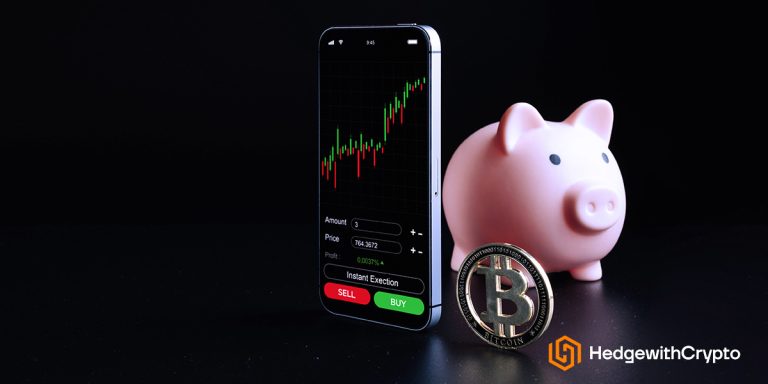Staking vs. Mining Comparison
Key Takeaways:
- Crypto staking and mining generate passive crypto rewards. However, staking differs largely because minimal capital is required to get started.
- Capital costs aside, mining crypto is generally more lucrative, whereas staking depends on the number of crypto being staked and people.
- Depending on the circumstances, crypto staking can be seen as a riskier venture as there are several risks with staking to consider.
TABLE OF CONTENTS
Staking and mining refer to earning cryptocurrencies by contributing to the blockchain ecosystem. The benefit of staking is that there is generally no up-front capital required to get started, and the entry barrier is much lower in terms of knowledge. On the other hand, mining crypto requires specific hardware to calculate complex mathematical calculations to validate transactions. The rewards vary depending on the cryptocurrency and, depending on the hardware contribution, are distributed to the miners as rewards.
Which is better? Staking crypto is a better option for beginners to earn passive rewards than mining. Users can get started immediately using a crypto staking provider that does not require technical experience, and there are zero upfront costs or ongoing expenses to maintain the mining rig. Cryptocurrency mining is geared toward experienced investors committed to contributing to a particular coin. Find out how to stake crypto and start mining in these articles.
Staking Explained Briefly
Staking cryptocurrencies is delegating a set number of tokens to an ecosystem in return for earning rewards. These rewards can be Annual Percentage Yields (APY) or Annual Percentage Returns (APY). Different exchanges and blockchains have another mechanism for staking.
In staking, the user holds a set number of tokens to a blockchain that then leverages those staked tokens to perform operations. Developed to manage the Proof of Staking Consensus Mechanism, staking leverages the staked tokens to verify and secure all the transactions with the blockchain.
At the time of writing, there are 245 Proof of Stake cryptocurrencies with a collective market capitalization of $230.74 billion. Some of the best staking coins include Ethereum (After the Merge Upgrade), Binance Coin, Cardano, Polkadot, Avalanche, Cosmos, Toncoin, Near Protocol, and Algorand.
Staking Pros:
- For those who don't want to engage directly with the volatile crypto market, crypto staking offers passive income. Holding the tokens in the blockchain to be leveraged by it in return for regular rewards is considered suitable by many investors. The passive rewards range from single to triple-digit percentage returns depending on cryptocurrency, exchanges, and the blockchain
- Staking only involves buying and holding the tokens in exchange. Depending on the cryptocurrencies, it also involves selecting the validators and delegating the coins to them, which can be done by only pressing the “staking” button. Due to that, staking is much easier to get into for beginners
- Environmental concerns are one reason why staking is more attractive than mining. Proof of stake coins consumes approximately 2.62 megawatts compared to Proof of Work's 5.13 gigawatts continuously at the time of writing
- No up-front costs (apart from buying the token) to get started compared to mining
Staking Cons:
- Market volatility can suddenly reduce the rewards investors can earn from staking cryptocurrencies. If staking rewards a high APY, the crypto's value fluctuation into bearish zones (price drops) can lead to a loss of funds. What exasperates this loss is that once locked, stakers can't simply un-stake their assets whenever they want
- Certain coins require a relatively high minimum staking. For example, after Ethereum's Merge Upgrade, investors must stake at least 32 ETH to participate in the blockchain. It prohibits most beginners who want to enter the Ethereum ecosystem and stake their tokens
- A cryptocurrency is liquid if it is easily bought and sold. In other words, an asset in demand is better for liquidity. However, when investors stake their tokens on cryptocurrency exchanges by participating in the “Earn” programs, their assets are removed from liquidity. Removing too many assets' liquidity zones leads to bearish market conditions for the staked cryptocurrency, which reduces its market value, hurting the profits of the stakers
- Proof of stake, the consensus mechanism that governs staking, is considered to be far less decentralized compared to Proof of Work that crypto mining operates on
Cryptocurrency Mining
Mining is creating new cryptocurrencies by solving mathematical problems to verify crypto transactions using specific computing hardware. Crypto mining was the first mode of earning cryptocurrencies in the market that started with Bitcoin. So far, 19.512 million Bitcoins have been mined. Mining is done according to the Proof of Work (PoW) mechanism in which the individual or institution operating the node is rewarded with crypto assets for their mining contribution.
At the time of writing, 312 PoW crypto assets have a market capitalization of $346.93 billion. Some of the best cryptos to mine include Bitcoin, Dogecoin, Litecoin, Ethereum Classic, Monero, Bitcoin Cash, Bitcoin SV, ZCash, and Dash.
Crypto Mining Pros:
- Mined crypto assets are considered more lucrative compared to staking. While environmental concerns are moving the attention away from mined crypto assets, most early investors still consider mining more profitable
- Mined transactions cannot be easily counterfeited. Mining requires a significant amount of hard resources, which makes it a heavy “investment” for those looking to counterfeit PoW assets
- PoW consensus that involves mining is much more decentralized than Proof of Stake since the former requires more participants in the network to approve the transactions
- Mining is one of the best ways to earn Bitcoin passively and cannot be staked
Crypto Mining Cons:
- Setting up a mining rig is costly. Furthermore, mining involves heavy electric bills. On average, it costs $0.05 per kilowatt hour to mine cryptocurrency.
- Issues for GPU and ASIC miners can develop as they perform the mathematical equations required to mine the crypto. Long-term and continuous usage of GPUs decreases their overall lifespan and, therefore, requires ongoing hardware replacement costs.
- Bitcoin mining's high-energy usage has led to global energy concerns. Countries have gone as far as to ban mining operations to prevent the overload of electricity demand.
- Individual miners will struggle to compete against the larger mining rigs and, therefore, only generate minimal returns compared to large mining companies that win a majority of the block rewards with superior GPU mining rigs.
The Differences Between Staking and Mining
The major differences between staking and mining are shown in the table below.
| Criteria | Staking | Mining |
|---|---|---|
| Easy of Use | Crypto stalking only involves holding a cryptocurrency in an exchange or in the staking pool and rewards are generated on a regular basis | Crypto mining involves running a node in the blockchain to verify the transactions and mine coins |
| Costs | Staking is far less costly. The cost of staking depends on the blockchain, the cryptocurrency exchange, and the crypto asset to be staked. That said, staking directly on the blockchain can be costly. Ethereum staking, for instance, requires 32ETH, which is in addition to to running and maintaining a node | Mining is extremely costly – especially for those who want to make significant gains through mining. And once the mining process initiates, the cost rises as high as $0.05 per kilowatt hour. |
| Fairness of rewards | Staking rewards are comparatively fair as compared to mining, The rewards depend upon the number of crypto assets staked, and people | Mining rewards depend on the quality of the mining rig, which is why many individual miners face issues since they can’t compete with institutional miners |
| Network security | Staking depends on a high number of tokens to secure the network | Proof of Work relies on hash rate to secure the network |
| Decentralization | Staking is considered much less decentralized than mining since it involves locking the assets. That is, one with the most assets locked will have the most power over the decisions made in the blockchain. It also encroaches upon the security of the POS network | Mining is more decentralized as compared to staking. It is because it requires more computers in the network to verify the transaction, as compared to POS, where the decisions can be altered based on the node with the most number of tokens staked |
Similarities Between Staking and Mining
While the difference between mining and staking is more pronounced, the following factors account for similarities between the two processes.
- Earn rewards. The purpose of mining and staking is the same. That is, to earn passive rewards using some form of investment. With staking, users earn interest based on the number of cryptocurrencies staked. Miners earn based on the degree of contribution they make.
- Requires a node. There are two types of staking techniques. One is a validator, and another is a delegator. A validator is responsible for staking their assets and running a blockchain node to verify the transactions and secure the network. Similarly, mining also involves running the node. In essence, both cases involve the agreement of involving nodes to validate a transaction.
- Profit depends on investment. For investors, the ultimate objective of staking and mining is to generate profits. Increased investment in both staking and mining can lead to potentially bigger profits. The number of tokens locked in staking platforms of liquidity protocols will lead to higher rewards. Similarly, using better mining equipment will solve more mathematical equations and get a bigger share of the mined crypto asset.
Staking vs. Mining Compared
Is staking or mining more profitable?
Staking is more profitable than mining since the former only involves buying and staking cryptocurrency assets. On the other hand, mining involves heavy hardware and high electricity bills that add overhead and harm the profit margins. The hardware to build an ASIC rig or GPU miner is upfront before any profit can be earned. In addition, the amount earned from staking is a lot higher initially, given how long it can take to mine 1 Bitcoin. Over the long term, assuming the value of the mined cryptocurrency increases, it could potentially make a lot of profit.
Is staking or mining riskier?
In certain circumstances, staking is considered riskier to earn passive income. Since a certain number of crypto assets have to be locked in the PoS blockchain to generate rewards, there is always a staking risk of losing the locked assets due to technical or regulatory issues. Moreover, when users stake their assets on centralized platforms, there is a risk of losing those assets if the exchange faces liquidity issues. For instance, FTX has $3.1 billion worth of assets locked in its ecosystem, which might not be returned to the people.
Another factor to consider is blockchain staking, in which the staker runs a validator node. An investor must pay two costs here: one for locking the assets and the second for maintaining the network. The loss of value of crypto assets under this circumstance will be more profound than that of mining.
In contrast, mining requires the use of hardware to mint crypto assets from the blockchain. Since there is no requirement for any asset to be locked, users are not at risk of dealing with additional losses.
Does staking or mining have better long-term value?
The second factor to consider is the value of the token. Since cryptocurrencies are speculative assets, both mining and staking are affected by them. However, a lower market value of crypto would cause more loss in mining when the resources and other overheads are considered. With staking, users would only incur loss under bearish market conditions based on the value of tokens, not the other assets involved in the process.
Final Verdict
Staking is the best option for beginners. It is free to start, and there are several one-click exchanges where you can deposit tokens and begin staking. After getting more acquainted with blockchain technology, they can focus on mining which is more suitable for experienced investors, provided they can deal with costs associated with the mining hardware. That said, investors must assess their risk tolerance and their ability to invest before selecting between staking and mining.




